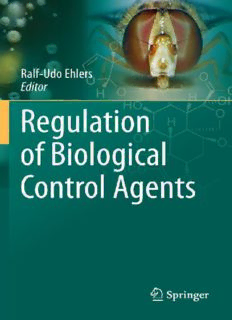
Regulation of Biological Control Agents PDF
Preview Regulation of Biological Control Agents
Regulation of Biological Control Agents Ralf-Udo Ehlers Editor Regulation of Biological Control Agents 123 Editor Ralf-UdoEhlers DepartmentforBiotechnology andBiologicalControl InstituteforPhytopathology Christian-Albrechts-UniversityKiel 24118Kiel Germany [email protected] Disclaimer The information in this book compiled by the authors and editor has been checked for accuracy and completeness. The information is in accordance with the standard practices acceptedatthetimeofpublication.However,neithertheauthors,editors,andpublisher,nor anypartyinvolvedinthecreationandpublicationofthisworkwarrantthattheinformationis ineveryrespectaccurateandcomplete,andtheyarenotresponsibleforerrorsoromissions orforanyconsequencesfromtheapplicationoftheinformationinthisbook. ISBN978-90-481-3663-6 e-ISBN978-90-481-3664-3 DOI10.1007/978-90-481-3664-3 SpringerDordrechtHeidelbergLondonNewYork ©SpringerScience+BusinessMediaB.V.2011 Nopartofthisworkmaybereproduced,storedinaretrievalsystem,ortransmittedinanyformorby anymeans,electronic,mechanical,photocopying,microfilming,recordingorotherwise,withoutwritten permissionfromthePublisher,withtheexceptionofanymaterialsuppliedspecificallyforthepurpose ofbeingenteredandexecutedonacomputersystem,forexclusiveusebythepurchaserofthework. Printedonacid-freepaper SpringerispartofSpringerScience+BusinessMedia(www.springer.com) Preface Regulation is implemented by governments when human activities may cause damage to the society or the environment in order to avoid, prevent or minimise impacts.Regulationshouldconcentrateonsafetyaspectsandtrytominimiseneg- ative consequences for trade and the economy. Biological control agents (BCAs) are generally regarded as sustainable and environmentally safe tools to manage pest insects, nematodes, weeds and diseases in agriculture, forestry and horticul- ture.However,nohumanactivityiswithoutpotentialrisks,soregulationofBCAs isnecessarytoavoidpotentialhazards. Plantprotectionproductsbasedonmicro-organisms,semiochemicalsandbotan- icalsaresubjecttoregistrationinallOECDcountries(OrganisationforEconomic Co-operationandDevelopment).Theirpotentialforuseinplantprotectionandsub- stitution of hazardous chemical substances is, however, not well exploited. One reason is the stringent regulation policy that basically follows rules implemented for registration of synthetic chemical pesticides. This situation motivated the EU Commission to call for proposals for appropriate and balanced regulatory systems for BCAs. As a result, the EU-supported REBECA (Regulation of Biological ControlAgents)PolicySupportAction(www.rebeca-net.de)wasstartedandgath- ered experts from academia, regulation authorities and industry with the objective of elaborating proposals that can accelerate the regulation process for BCAs and make it more cost-effective without compromising the level of safety for human health and the environment. Based on assessments of the potential risks of BCAs, including invertebrate agents, proposals for improvement of existing registration requirementsandadministrationofregulationweredeveloped. ThisbooksummarisestheresultsoftheREBECAAction.Itisalsoacomprehen- siveguidefortheregistrationpracticeandrequirementstoapplyforauthorisationof biologicalcontrolagents.Inthefirstpartofthebook,anoverviewonexistingregu- lationrequirementsandthegeneralpracticeinOECDcountriesissummarisedand policyaspectsarereviewedanddiscussed.Inthesecondpartofthebook,informa- tiononbenefitsandrisksofthedifferentbiologicalcontrolagentsarereviewedby experiencedscientistswhohavebeenworkingfordecadesinthefieldofbiological control.Thispartcanalsobeusedbyauthoritiestogetanoverviewontherealrisks related to the use of these agents. In the last part, the results of discussion among v vi Preface participantsoftheREBECAActiononhowregulationofBCAscanbeimprovedin thefutureissummarisedbythemembersoftheREBECAconsortium. This book will be of great help for those dealing with regulation of biological controlagentsinregistrationauthoritiesandindustry.Itisalsoimportantforthose whodevelopnewproductsbasedonBCAs,astheyshouldalwayshaveinfocusthe registrationrequirementsduringdevelopmentofbiocontrolproducts.Last,butnot least,thisbookcanfunctionasthebasisforfutureactivitiesanddiscussionsonhow toimprove existing regulation requirements.The REBECA Action wasasuccess- fulplatformforexchangeofexperienceinregulationanddevelopmentofpossible amendments. I hope, policy-makers, scientists, member of regulatory authorities andtheprivatesectorwillcontinuetheirco-operationsstartedwithintheREBECA Action in order to make plant protection safer, life easier for farmers and provide healthierfoodproduceforconsumers. The preface of this book is also a good opportunity to express my thanks to all who have contributed to the REBECA Action and to producing this book. The firstacknowledgementgoestotheunknownEUofficialswhotooktheinitiativefor the call (Sixth Framework Program of the EU. Call identifier: FP6-2004-SSP-4). Without their initiative we would today probably have to deal with more data requirements instead of fewer. Thanks are also due to the EU Commission for the financialsupport. MyparticularthanksgotoOlafStrauchforhisprofessionalmanagementduring the Action’s lifetime and to Miriam Döring and Heike Kuhlmann for their sup- port in organisation of meetings and in administration. Thanks also to Dr. Ingmar SchmidtandSusanneNeufeldtattheChristian-Albrechts-UniversityKielforkeep- ing a scientist in line with EU administrative rules. My warmest regards go to my colleagues of the REBECA consortium, who were the backbones for success: Rüdiger Hauschild contributed his in-depth professional know-how in registration ofBCAs;AnitaFjelstedmanagedtoattractregulatorypersonnelandinitiatefruit- ful networking among all stakeholders; Wyn Grant, the grey eminence, with an excellent feeling for what would be acceptable for EU and MS policy; Jeff Bale, who linked with the IOBC executives; Uli Kuhlmann, with his scientific excel- lence in risk assessment and links to friends of biological control all around the world;BernardSpeiserandLuciusTammwithexcellentcontactstoorganicagricul- ture and professional skills in Swiss-EU-network management; Heikki Hokkanen andIngeborgHokkanen-Menzlerprovidedtheirexpertiseinsocio-economics;and HermannStrasser,whocontributedtheresultsofthepreviousEUprojectsonsafety aspects (BIPESCO and RAFBCA). These were, of course, not their only qualities andIamparticularlythankfultoallofthemfortheirsupportthatmadetheREBECA Projectasuccess.Mygratitudealsototheotherauthorsofthisbookandtheircon- tributions to REBECA, in particular to Claude Alabouvette, for contributing his long-termexperienceinregulatoryaspectsandisneverendingsupporttobiological control.ThanksalsotoRolandPerryforproofreadingandtoSuzanaBernhartand ElisabeteMachado(Springer)fortheirsupport. I also want to thank all participants from biocontrol companies, universities andresearchorganisations,regulatoryauthoritiesandconsultancycompanies,who Preface vii cametojointheworkshopsanddiscussionsduringtheREBECAAction.Wewould nothavebeenabletoprovidesomuchinformationwithinsuchashorttimewithout their input.Ialsothank colleagues fromoverseas, inparticular BillSchneider and TrevorJackson.MysincerethanksalsotoUlfHeiligforprovisionofhisexpertise as a consultant and his support to our activities to inform the biocontrol industry aboutREBECA. I hope this book will stimulate co-operation and activities for further improve- ment of regulatory policy. Finally, for those who work in biological control and haveforthefirsttimebeenconfrontedwithregulationofthesewonderfulbiocontrol techniques,pleasedonotgetfrustrated;thereislightattheendofthetunnel. Kiel,Germany Ralf-UdoEhlers August2010 Contents PartI GeneralAspectsofRegulation 1 RegulationofBiologicalControlAgentsandtheEUPolicy SupportActionREBECA . . . . . . . . . . . . . . . . . . . . . . 3 Ralf-UdoEhlers 2 Regulation According to EU Directive 91/414: Data RequirementsandProcedureComparedwithRegulation PracticeinOtherOECDCountries . . . . . . . . . . . . . . . . . 25 RüdigerHauschild,BernhardSpeiser,andLuciusTamm 3 AnInternationalComparisonofInvertebrateBiological ControlAgentRegulation:WhatCanEuropeLearn? . . . . . . . 79 EmmaJ.Hunt,AntoonJ.M.Loomans,andUlrichKuhlmann 4 RegulationofPlantProtectioninOrganicFarming . . . . . . . . 113 BernhardSpeiserandLuciusTamm 5 PolicyAspectsofRegulation . . . . . . . . . . . . . . . . . . . . . 127 WynGrant 6 Cost-Benefit,RiskandTrade-OffAnalysisofRegulation . . . . . 139 Ralf-UdoEhlers PartII RisksandRiskAssessment 7 RisksofMicrobialBiocontrolAgentsandRegulation: AreTheyinBalance? . . . . . . . . . . . . . . . . . . . . . . . . . 157 ClaudeAlabouvetteandChristelleCordier 8 EcologyandHumanPathogenicityofPlant-Associated Bacteria . . . . . . . . . . . . . . . . . . . . . . . . . . . . . . . . 175 GabrieleBerg,ChristinZachow,MassimilianoCardinale, andHenryMüller 9 MetaboliteToxicologyofFungalBiocontrolAgents . . . . . . . . 191 HermannStrasser,StefanHutwimmer,andWolfgangBurgstaller ix
Description: